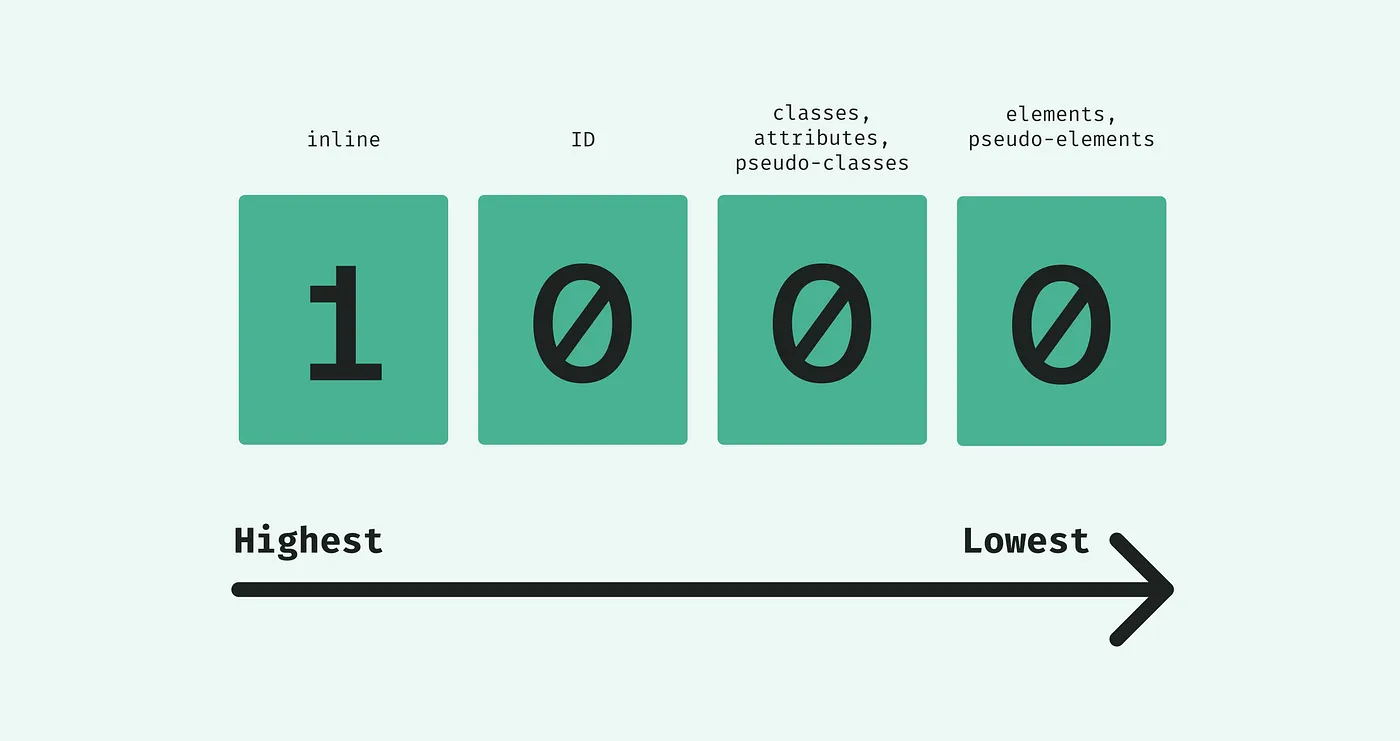Master CSS Specificity: A Comprehensive Guide for Beginners
 Keyur Chaudhari
Keyur ChaudhariTable of contents
- TL;DR
- Introduction
- What is CSS Specificity?
- The Cascade Algorithm
- Understanding Selector Types and Their Specificity
- How CSS Resolves Conflicts: A Step-by-Step Example
- The Importance of Selector Position in CSS
- Calculating Specificity
- Handling Conflicting Styles with Specificity
- The Role of !important in Specificity
- Conclusion
- FAQs

TL;DR
CSS specificity determines which styles are applied when there are conflicting rules. It’s calculated based on the types of selectors used: inline styles (most specific), ID selectors, class/attribute selectors, and element selectors (least specific). When selectors have the same specificity, the last one in the code is applied. The !important rule can override all other rules, but it should be used sparingly. Understanding specificity helps you write cleaner, more maintainable CSS, ensuring your styles behave as expected.
Introduction
CSS (Cascading Style Sheets) is a powerful tool that controls the visual presentation of web pages. One of the most crucial aspects of CSS is understanding how the browser determines which styles to apply when there are conflicting rules. This process is governed by a concept known as specificity. In this guide, we’ll explore how specificity works in CSS, breaking down the core concepts and providing practical examples. By the end of this article, you’ll have a solid understanding of how to manage conflicting styles and make your CSS more predictable.
What is CSS Specificity?
CSS specificity is a set of rules that determines which CSS property values are applied to an element when multiple declarations conflict. It is calculated based on the types of selectors used in a rule. Specificity helps the browser decide which style to apply, ensuring that the most appropriate rule is used.
The Cascade Algorithm
Before diving into specificity, it’s essential to understand the Cascade Algorithm, which is the foundation of CSS. The cascade algorithm is what the "Cascading" in CSS stands for. It’s the process by which the browser decides which styles to apply, and it works by considering several factors:
Importance (Inline styles or
!importantrules).Specificity (Which we'll discuss in detail).
Source order (The order in which styles are written in the CSS file).
Understanding Selector Types and Their Specificity
In CSS, different selectors have different levels of specificity:
Inline Styles: These have the highest specificity, directly applied to an element using the
styleattribute in HTML. They are given 1000 points in specificity.ID Selectors: These are highly specific, with a specificity value of 100.
Class, Attribute, and Pseudo-class Selectors: These have a medium level of specificity, each adding 10 points.
Element and Pseudo-element Selectors: These are the least specific, with a specificity value of 1.
Universal Selector (
*): This has a specificity value of 0.
How CSS Resolves Conflicts: A Step-by-Step Example
Let’s consider an example where multiple classes are applied to an element:
<h1 class="yellow cred cpurple">CSS Specificity</h1>
And the CSS:
h1 { color: aqua; }
.yellow { color: yellow; }
.cred { color: red; }
.cpurple { color: purple; }
Here’s how the browser decides which color to apply:
The
h1element is first given a color of aqua.Then,
.yellowis applied, changing the color to yellow.Next,
.credchanges the color to red.Finally,
.cpurplechanges the color to purple.
Since all the selectors are classes and have the same specificity (10 points each), the browser applies the last one in the source order, which is .cpurple. Therefore, the text will be purple.
The Importance of Selector Position in CSS
If selectors have the same specificity, CSS will apply the one that appears last in the code. For example:
.yellow { color: yellow; }
.cpurple { color: purple; }
In this case, .cpurple will take precedence over .yellow, applying the purple color.
Calculating Specificity
Specificity is calculated as a four-part value, such as 0, 1, 0, 0 for an ID selector. Here’s a quick guide:
Inline Styles: 1, 0, 0, 0
ID Selectors: 0, 1, 0, 0
Class Selectors: 0, 0, 1, 0
Element Selectors: 0, 0, 0, 1
For example, the selector h1.yellow has a specificity of 0, 0, 1, 1 because it includes one element selector (h1) and one class selector (.yellow).
Handling Conflicting Styles with Specificity
When you have conflicting styles, understanding specificity can help you control which styles are applied. Always aim to use the least specific selector necessary to achieve the desired style. This approach not only keeps your CSS more manageable but also makes it easier to override styles if needed.
The Role of !important in Specificity
The !important rule is a way to force a style to be applied regardless of specificity. It overrides inline styles and any other CSS rules. However, overusing !important can make your CSS difficult to maintain, as it becomes challenging to override these styles.
Example:
.yellow { color: yellow !important; }
In this case, the yellow color will be applied even if there are other styles with higher specificity.
Conclusion
Understanding CSS specificity is essential for any web developer. It allows you to predict which styles will be applied, helping you to avoid unintended results and make your code more maintainable. By mastering specificity, you can create cleaner, more efficient CSS that behaves exactly as expected. Remember to use selectors wisely, avoid overusing !important, and keep your CSS as simple as possible to ensure that your styles are easy to manage and override when necessary.
FAQs
What is CSS specificity?
- CSS specificity is a set of rules that determines which CSS property values are applied to an element when multiple declarations conflict.
How is specificity calculated?
- Specificity is calculated based on the types of selectors used: inline styles, ID selectors, class/attribute selectors, and element selectors, in descending order of specificity.
What is the role of
!importantin CSS?- The
!importantrule forces a style to be applied, overriding any other declarations, including inline styles.
- The
How can I override a style with lower specificity?
- To override a style with lower specificity, you can use a more specific selector or the
!importantrule.
- To override a style with lower specificity, you can use a more specific selector or the
Why is it important to understand CSS specificity?
- Understanding CSS specificity helps you control which styles are applied, making your CSS more predictable and easier to manage.
Subscribe to my newsletter
Read articles from Keyur Chaudhari directly inside your inbox. Subscribe to the newsletter, and don't miss out.
Written by

Keyur Chaudhari
Keyur Chaudhari
Frontend Engineer with 6+ years of experience developing scalable and efficient web applications. Looking to be a better software engineer everyday.